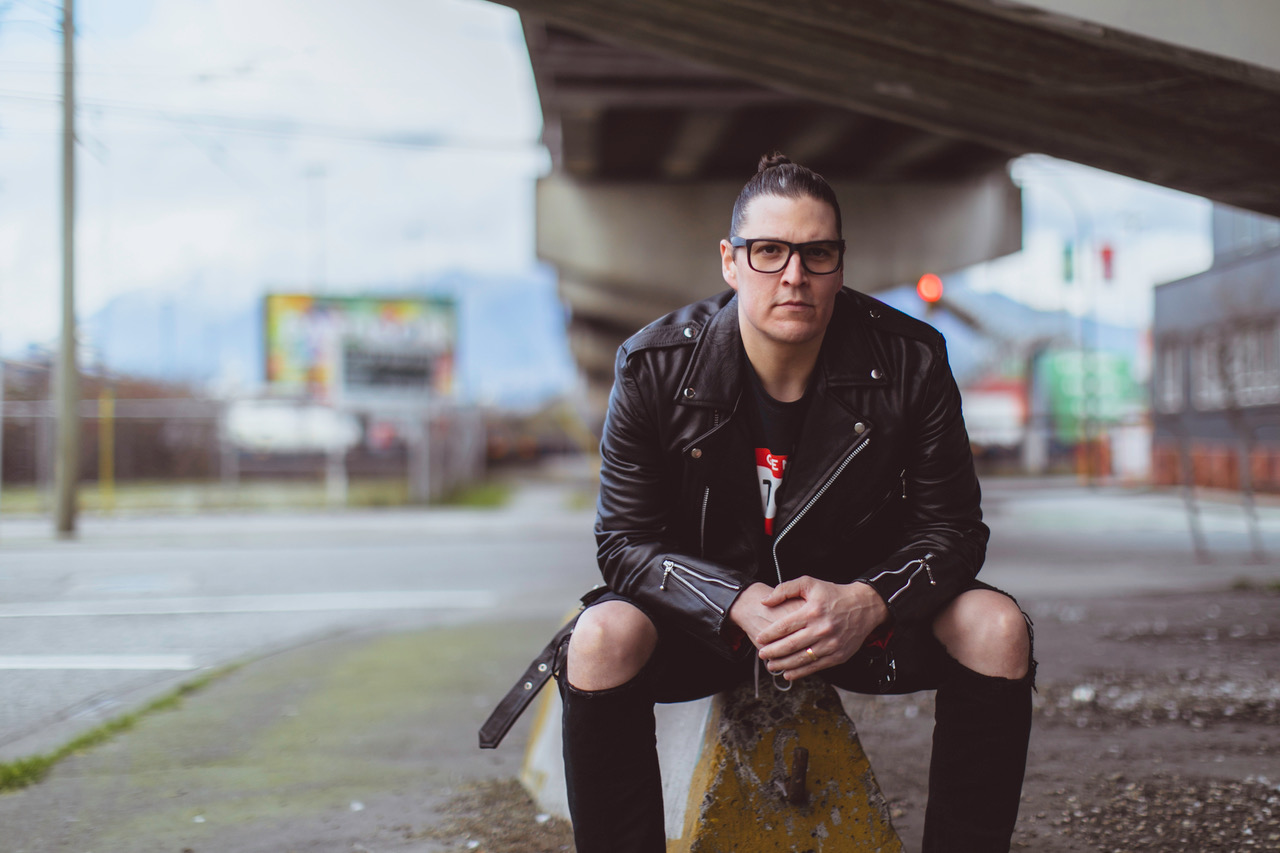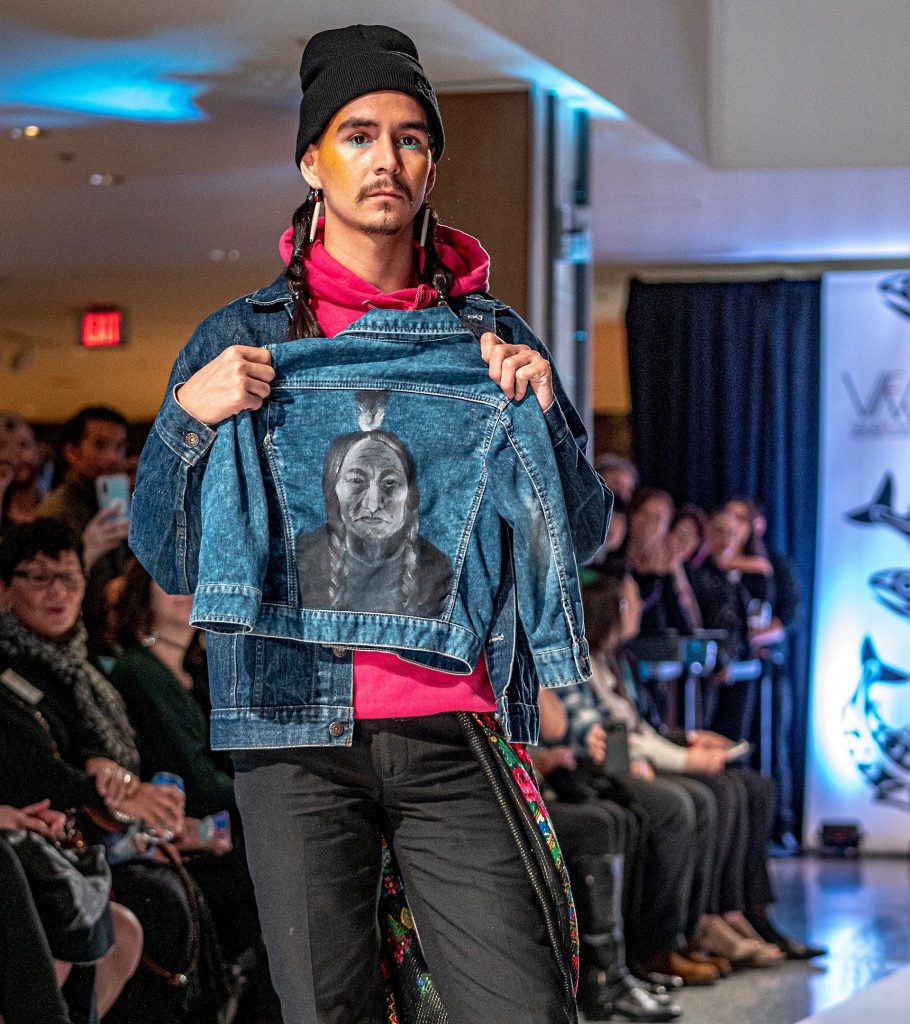
Section 35 founder, Justin Louis | Photo by Nadya Kwandibens
Due to unprecedented times worldwide, the shift from in-person events has turned to virtual and online streaming. The biennial Indigenous Fashion Week Toronto (IFWTO) presented 15 designers showcasing innovative and choreographed runway presentations during four days in November 2020.
The festival included Indigenous-made designs and collections that sold out in a virtual marketplace within hours, a digital art exhibition (A Thread That Never Breaks), and in collaboration with Ryerson University’s School of Fashion with a Fashioning Resurgence Symposium.
The live panel events included nine conversations of masterclasses in branding and communications, colours, materials and symbols, fashion business, connection to ancestral knowledge, fashion journalism, land-based fashion, beading table discussions, and Indigenous fashion education. Notably, Christi Belcourt focused on her craft and Indigenous designs through collaboration and breaking into mainstream fashion with fashion-house Valentino.
The designers of IFWTO, Mobilize Waskawewin (Dusty LeGrande), Section 35 (Justin Louis) and Evan Ducharme spoke about their experiences and debut fashion presentations with Tu Gh’eh Tl’e’th (Streams) and Tu Gh’eh Nah (Water is Life).
Evan Ducharme
Evan Ducharme, a Métis artist with ancestral ties to the Cree, Ojibwe and Saulteaux people, is from the historic Métis community of St. Ambroise, Manitoba (Treaty 1 Territory). Ducharme currently resides and works with gratitude on the ancestral, traditional, and unceded territories of Musqueam, Tsleil Waututh, and Squamish Peoples of Vancouver, British Columbia. His work has an array of separates, outerwear, and eveningwear with the look of heightened utilitarianism. Ducharme’s signature Métis iconography is woven throughout. His cultural iconography focuses on Indigeneity reclamation, reclamation of Indigenous sexualities, and a commitment to environmentally-conscious practices.

Ducharme explains that the inspiration for his collection for IFWTO incorporated, “delving into the profound sense of connection I feel to the unknown queer ancestors who have always been present in my work and bringing them to the center.” He simultaneously considered what it meant to be a collective of descendants, which is how he views his own community, his community of Indigenous queers, and his immediate family. The word “Progeny” transpired intricate versions of classic staples, embroidery layouts, traditional techniques, flesh-toned palettes and shades with beige-colour silhouettes.
Ducharme’s focus and message in his designs are inextricably linked to his identity. He says, “I aim to use my work as a possible avenue for people to learn the truth about how this country became a country, and my Métis ancestors’ role within that history.” Ducharme believes that the personal connection with clothes tells the stories one wears and can subtly spread the deception of historical ongoing colonial violence with engraved statements on accessories of leather keychains with Unsettle, Decolonize and Resist.
The selection of made-to-order pieces on Evan Ducharme’s online store is currently unavailable due to the high demand for his elegant and intricate custom pieces.
Mobilize Waskawewin
Dusty LeGrande is a Cree fashion designer and artist that established Mobilize Waskawewin, a streetwear clothing brand that is creating statements through cultural awareness and translates to movement in the Cree language. With IFWTO, Dusty presented pieces explaining, “Streetwear is the fashion of the people, the fashion of the youth. I believe it is vital that what I create speaks loud and creates dialogue on how we can collectively nurture future generations.” The Future Ancestors presentation included cropped hooded sweaters, flare pants of Cree syllabic symbols with vivid colours of yellow, blue, purple, acid wash, and black denim jackets of patch-designed three-tone backing titling.
Dusty LeGrande expresses, “IFWTO was an honour to be a part of, as one of Turtle Island’s biggest Indigenous fashion experiences. I felt it was important to share perspective through my art.” He says, “Because of the lack of representation of Indigenous people it is important to show our beauty and diversity.”
The designs and garments that Indigenous people have worn since time immemorial have been appropriated in the mainstream fashion realm for many decades but today, young Indigenous people express themselves through fashion, identity and cultural awareness. Dusty says, “Clothing is a powerful form of communication. Every single Indigenous voice is important. I hope everything I create can empower others to use their voice.” He philosophizes that it’s important to him that these messages are present in the clothing to allow people a form of communication. The voice behind the clothing is inspired by the ancestors of the present and the future.

Section 35
Justin Louis is a Nêhiyaw who specializes in creating streetwear designs with his brand, Section 35, which is based in Vancouver, British Columbia. Launched in 2016, Indigenous iconography became a staple for spreading Indigenous knowledge, cultural values and awareness.
Their gear includes t-shirts, hoodies, and sweatpants with statements like ‘Take Only What You Need’, depicting what Indigenous people did to care for the land prior to North American colonization. ‘The Unceded Territory’ shirts depict what is meant by Section 35, a section of the Constitution Act ‘that recognizes and affirms Aboriginal rights, the existing Aboriginal and treaty rights of the Aboriginal peoples of Canada are hereby recognized with First Nations, Inuit and Métis peoples of Canada.’ Nations Skate Youth contributed a t-shirt design that features a teepee with inverted yellow and pink colours, and a young person wearing a shawl doing an Ollie (a jump skateboard trick).
Justin Louis believes that it is crucial to address and bring awareness of Indigenous issues with Indigenous iconography in streetwear clothing. He states, “It’s important that we as Indigenous people create something that comes from an authentic place and tells our stories. We are the storytellers and I think our art and iconography is just an extension of that storytelling.” Indigenous people often reflect and live in ‘two worlds’ of Westernized society and the Indigenous way of life. Louis adds, “People have tried to do that for us, but we are now taking that back and doing it ourselves especially in streetwear. I like to think a lot of us walk between two worlds and it’s nice to have something that represents who we are in streetwear and the fashion world.” He then explains that there is a whole new generation of creatives emerging which is exciting to witness.

One of the many favourable pieces that sold out quickly were Louis’ custom jackets. He says, “I am definitely proud of the custom jackets I make. The time and effort to make one-of-a-kind pieces and watching them walk down a runway, show up in photos and social feeds is always exciting.” His other favourite is the ‘Kill Mascots’ camo jacket that he designed a few years back that sold out almost immediately. He says, “I didn’t even get one. I really just love designing jackets and coats. I think people really love them!”
Another piece showcased in IFWTO that Justin Louis enjoyed designing was ‘The Sylleopard Coat’. He explains, “It was a favourite to design. I worked for a while to find a way to bring that to life just for IFWTO. I hope to be able to release it to the public sometime. Also, the ‘RED Varsity Jacket’ with syllabics and chenille patches is another design. The response to that piece was amazing. I hope to release a version of that as well for the fifth-year anniversary.”
The designers of IFWTO have different artistry of various forms but connect together in a cohesive narrative which is Indigenous Fashion and Design, a narrative that describes teachings, community, history and contemporary elements. Just like Indigenous people, IFWTO continues to grow and thrive no matter the circumstances.










